
Carne de Ávila (Beef from Avila) is a protected geographic designation for beef originating from the Province of Ávila in Spain. The designation was approved in 1988. [1]

Carne de Ávila (Beef from Avila) is a protected geographic designation for beef originating from the Province of Ávila in Spain. The designation was approved in 1988. [1]
Carne de Ávila is produced exclusively from livestock of the Avileña-Black Iberian breed found throughout the region of Castile and León. The regulatory board is headquartered in the city of Ávila.
The Avileña-Black Iberian breed is an evolved specimen from the serrana race, crossed with other breeds of the region, which has resulted in a small population of animals of uniform black coat, although some individuals exhibit degradations on the skin tone.
Carne de Ávila is the source of the original raw t-bone, a typical dish of the Province of Ávila.

Spanish cuisine consists of the traditions and practices of Spanish cooking. It features considerable regional diversity, with important differences between the traditions of each of Spain's regional cuisines.
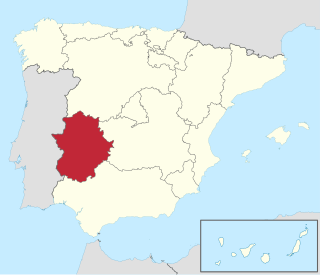
Extremadura is a landlocked autonomous community of Spain. Its capital city is Mérida, and its largest city is Badajoz. Located in the central-western part of the Iberian Peninsula, it is crossed from east to west by the Tagus and Guadiana rivers. The autonomous community is formed by the two largest provinces of Spain: Cáceres and Badajoz. Extremadura is bordered by Portugal to the west and by the autonomous communities of Castile and León (north), Castilla–La Mancha (east), and Andalusia (south).

Castile and León is an autonomous community in northwestern Spain. It was created in 1983 by the merging of the provinces of the historic region of León: León, Zamora and Salamanca with those of Old Castile : Ávila, Burgos, Palencia, Segovia, Soria and Valladolid. The provinces of Santander and Logroño, which until then had been included in the Old Castile administrative division, opted out of this merger and formed the new Autonomous Communities of Cantabria and La Rioja respectively. Condado de Treviño and La Puebla de Arganzón, the two municipalities that make up the Treviño enclave, are geographically surrounded by the neighboring Basque Country Autonomous Community, but belong to Castile and León.

Corned beef, or salt beef in some Commonwealth countries, is salt-cured brisket of beef. The term comes from the treatment of the meat with large-grained rock salt, also called "corns" of salt. Sometimes, sugar and spices are added to corned beef recipes. Corned beef is featured as an ingredient in many cuisines.
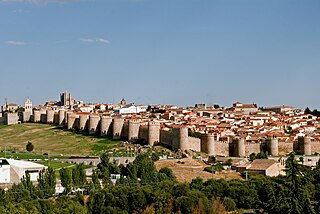
Ávila is a city of Spain located in the autonomous community of Castile and León. It is the capital and most populated municipality of the Province of Ávila.

Jamón ibérico, "Iberian ham", is a variety of jamón or presunto, a type of cured leg of pork produced in Spain and Portugal.

Galician cuisine refers to the typical dishes and ingredients found in the cuisine of the autonomous community of Galicia, Spain. These include shellfish, empanadas, polbo á feira, cheese queixo de tetilla, ribeiro and albariño wines, and orujo liquor. Similarly, to Asturian cuisine, Galician dishes have maintained several Celtic links, namely with different stews.
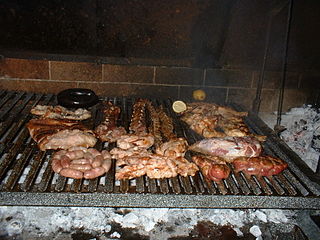
Beef is a key component of traditional Argentine cuisine. In 2019, Argentina was the 4th largest producer of beef, with a production of 3 million tons.

The Chianina is an Italian breed of large white cattle. It was formerly principally a draught breed; it is now raised mainly for beef. It is the largest and one of the oldest cattle breeds in the world. The bistecca alla fiorentina is produced from its meat.

The Romagnola is a breed of cattle from the Emilia-Romagna region of Northern Italy. It belongs to the Podolic group of grey cattle. Romagnola cattle were used principally as draught beasts in the past; since the mechanisation of agriculture in the middle of the twentieth century they have been bred primarily for beef production.

Candeleda is a town and municipality located in the province of Ávila, in the autonomous community of Castile and León, Spain. According to the 2011 INE census, the municipality has a population of 5,213 inhabitants, making it the fifth largest municipality in the province after Ávila –the capital–, Arévalo, Arenas de San Pedro and Las Navas del Marqués. The town is located on the southern hillside of the Gredos mountains, 432 m above sea level, giving it a microclimate with a thermal regime of mild winters and hot summers and average summer temperatures of 26 °C.

Lechazo is a Spanish dish made from "cordero lechal".
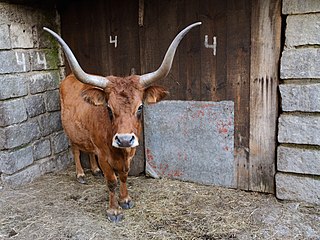
The Cachena is a breed of triple-purpose cattle from Portugal and Galicia, Spain. In Portugal, there is also the similar but larger cattle breed known by the name, Barrosão or Barrosã. Cachena and Barrosã are sometimes considered variants of the same race.

The Mirandesa is a Portuguese breed of beef cattle. It originates in – and is named for – the Terra de Miranda, the area of north-eastern Portugal where Mirandese is spoken, particularly the municipality of Miranda do Douro. It was formerly used as a draught animal, and was distributed throughout almost all of the country. It is now reared for beef; the meat may be marketed as Denominação de Origem Controlada.

Lechazo de Castilla y León is a protected-origin food product in the European Union consisting of milk-fed lamb meat, produced in Castile and León (Spain). The Geographical indication (GI) was authorized in 1997. The GI encompasses 483 farms from all of the grain-producing counties of Castilla y León, producing more than 167,000 lechazos per year. The Indicación Geográfica Protegida (I.G.P.) Council headquarters is located in Zamora, Spain.

Judías de El Barco de Ávila beans from the El Barco of Ávila is a protected geographic designation for local bean crops. It was designated on January 5, 1989.

Porco Bísaro is a domestic pig breed that is native to Portugal, typically from the Trás-os-Montes, Alto-Douro, Minho, and Beira regions.
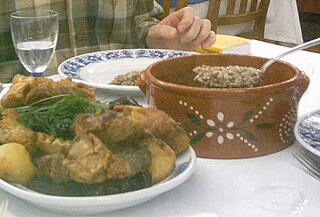
Rojões also known as rojões à moda do Minho is a typical fried pork dish of Portuguese cuisine, in particular, of the Minho Province in the wider Norte region of northern Portugal but with several regional variants across the country. Rojões is also the name for boneless pieces of pork meat, but with some fat. In the North of Portugal, rojões are pork cuts from the leg, shoulder or belly, fried in lard in a pan, preferably made of iron, which is a typical regional dish well-known across the entire country and easily found also in almost all parts of Portugal. There are variants like those from Bairrada, Porto and Minho Province. The nationally-famous carne de porco à alentejana, which always has clams as an ingredient and is named after the region of Alentejo, is indeed a dish of rojões with clams, also called rojões [de porco] à Alentejana, with or without clams.

Tortang carne norte, also known as corned beef omelette, is an omelette or fritter from Filipino cuisine made by pan-frying an egg and shredded canned corned beef mixture. It is usually seasoned with salt and black pepper, but it can also include onions, scallions, garlic, and/or sugar. It is a popular breakfast meal in the Philippines and is eaten with white rice or pandesal.